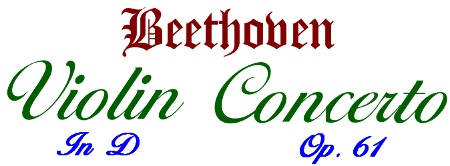 |
It’s a sad but oft-told tale in classical music – far too many of the masterpieces we have come to cherish were ignored in their own time, and their composers died having no clue of the esteem in which their work would be held by later generations. Ludwig van Beethoven’s only violin concerto, now widely acclaimed as the greatest of all, sunk into oblivion after its bizarre premiere and began to attract notice only a generation after his death.
 The violin seems an inherently attractive instrument for a concerto. David D. Boyden and Peter Walls hail it as “one of the greatest triumphs of instrument making … capable of poetic agility and brilliant figuration, making possible in one instrument the expression of moods and effects that may range … from the lyric and tender to the brilliant and dramatic. The violin seems an inherently attractive instrument for a concerto. David D. Boyden and Peter Walls hail it as “one of the greatest triumphs of instrument making … capable of poetic agility and brilliant figuration, making possible in one instrument the expression of moods and effects that may range … from the lyric and tender to the brilliant and dramatic. 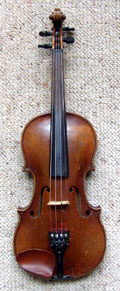 Its capacity for sustained tone is remarkable and scarcely another instrument can produce so many nuances of expression and intensity.” They attribute its emotional appeal to its close modeling of the human voice. String expert Tully Potter adds that the violin must be held close to, and thus becomes a part of, the player. From its origins in the bowed fiddles and rebecs of the Middle Ages, by the late 17th century the Amati, Guarneri, Stradivari and other great instrument-making families of Cremona had perfected the design, wood and finishes of the violin. By Beethoven’s time it was being further modified for volume and brilliance. Potter catalogs the evolutionary changes as longer fingerboards, more angled necks, greater string tension (and a concurrent rise in pitch), stronger bass bars and an added chin rest for more precise control, together with longer, heavier and more efficient bows. Its capacity for sustained tone is remarkable and scarcely another instrument can produce so many nuances of expression and intensity.” They attribute its emotional appeal to its close modeling of the human voice. String expert Tully Potter adds that the violin must be held close to, and thus becomes a part of, the player. From its origins in the bowed fiddles and rebecs of the Middle Ages, by the late 17th century the Amati, Guarneri, Stradivari and other great instrument-making families of Cremona had perfected the design, wood and finishes of the violin. By Beethoven’s time it was being further modified for volume and brilliance. Potter catalogs the evolutionary changes as longer fingerboards, more angled necks, greater string tension (and a concurrent rise in pitch), stronger bass bars and an added chin rest for more precise control, together with longer, heavier and more efficient bows.
Robin Stowell notes the irony that the greatest violin concertos were written by pianists. Indeed, like most composers Beethoven was best known as an expert pianist, but also was quite familiar with strings – he served for three years as a violist in the Bonn court orchestra and also played the violin, although not especially well – reportedly his intonation was erratic even before the onset of his deafness. In the early 1790s he began a violin concerto in C (WoO 5) in a solid, late-classical idiom, of which we have only the first 259 bars. As the fragment is fully orchestrated and breaks off after 20 full pages in the midst of the development, scholars are divided as to whether the remainder was abandoned or merely lost. (Beginning with Josef Hellmesberger in 1870, at least four attempts at completion have been published.) In addition to numerous sonatas, trios and quartets in which the violin plays a prominent part, by 1802 Beethoven had gone beyond chamber music to write two romances for violin and orchestra (Opp. 40 and 50) whose simplicity and lyricism evoke the French style of the 1770s, and in 1804 he produced a “triple concerto” for violin, cello, piano and orchestra (Op. 56) that harked back to the baroque practice of juxtaposing a smaller ensemble, rather than a bare soloist, against the full orchestra.
 The initial impetus and destiny of Beethoven’s Violin Concerto in D, Op. 61 were intimately tied to Franz Clement, a violin and piano prodigy. Upon first hearing him in 1794 Beethoven was hugely impressed and predicted in the 14-year old’s autograph album that he “would reach the greatest goal possible to an artist here on earth” and implored him to “return soon so that I may hear your dear magnificent playing.” The initial impetus and destiny of Beethoven’s Violin Concerto in D, Op. 61 were intimately tied to Franz Clement, a violin and piano prodigy. Upon first hearing him in 1794 Beethoven was hugely impressed and predicted in the 14-year old’s autograph album that he “would reach the greatest goal possible to an artist here on earth” and implored him to “return soon so that I may hear your dear magnificent playing.”
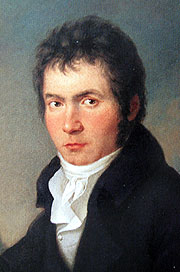
Beethoven in 1804
Portrait by Joseph Mahler |
Their paths next crossed when Beethoven’s “Eroica” Symphony was given its premiere at an 1805 concert featuring one of six violin concertos Clement wrote for himself. (Ironically, Beethoven's masterpiece was given short shrift by critics in comparison to the concerto, which was deemed “really splendidly performed and beautifully composed.”) Heard today, the Clement concerto is pleasant but rather conventional, with neither especially memorable melodies nor challenging solo turns. (More interesting as a display piece is his 11-minute Concertino Brilliante in the extreme key of F-sharp Major for violin and string quartet, with an especially catchy finale.) Yet its sheer length of over 40 minutes far exceeded that of any prior violin concerto and paved a way for Beethoven to follow. Clive Brown asserts that its structure and musical language derive from Beethoven’s piano concertos and testify to Clement’s admiration for Beethoven. That esteem might have been mutual – Brown speculates that Beethoven wrote his own concerto in appreciation for Clement’s support, especially as the two works share common keys, instrumentation and figurations. Stowell goes further to suggest that the similarities between the two composers’ D major concertos (and the sharp break in style from Beethoven’s recent Triple Concerto) imply a high degree of collaboration. Pincherle asserts that the high range and overall sweetness of the violin part were intended to exploit the hallmarks of Clement’s style – a remarkable fluency in the upper register and delicate arabesques that decorate the melodies. Thus in 1805 the Allgemeine musikalishe Zeitung distinguished him from “vigorous, bold, powerful playing” and characterized his approach as having “rather an indescribable delicacy, neatness and elegance, an extremely delightful tenderness and purity.”
Yet well beyond its sheer scope Beethoven’s concerto was revolutionary, albeit in a rather discreet way. Stowell credits it with being far removed from the conception of Beethoven’s contemporaries, replacing their formal freedom with a tightly-knit symphonic structure in which the soloist becomes a commentator upon and embellisher of the orchestral themes and statements. Paul Henry Lang adds that this melding of styles saved the further development of the concerto from becoming a mere pretext for exhibitions of virtuosity. Rather, Boris Schwartz states that Beethoven transformed the idiomatic features of the decorative French style from simple technical displays into the enhancement of profound ideas. Barry Cooper adds that the themes are symphonic in the sense of relating to the opening motif and creating a sense not only of symphonic breadth but cohesion and development. Anthony Hopkins posits a psychological dimension – unlike a symphony, a concerto contains a subtle suggestion that something is missing and so the soloist assumes the role of a hero to triumph over the orchestral gaps and thus earns our identification. David Johnson notes one further precedent – by pouring himself into a single violin concerto, Beethoven set a trend. Thus while Mozart and Haydn each wrote multiple violin concertos (not to mention Vivaldi, who wrote hundreds), after Beethoven, with very few exceptions, major composers contented themselves with only one – consider: Mendelssohn, Schumann, Brahms, Tchaikovsky, Dvorak, Sibelius, Nielsen, Stravinsky, Berg, Schoenberg, Barber … .
 The overall structure of Beethoven’s Violin Concerto derives from the classical model typified by Mozart (and that would continue to serve as a template for most of the following century). The overall structure of Beethoven’s Violin Concerto derives from the classical model typified by Mozart (and that would continue to serve as a template for most of the following century).
The Timpani Phrase and the Opening Theme:

The Dramatic Entrance of the Solo Violin:

Other Themes of the First Movement:



The Themes of the Larghetto:


The Recurring Theme of the Rondo:

The "B" and "C" Episodes of the Rondo:


|
 Allegro ma non troppo – The first movement is cast in standard sonata form, but with plenty of inventive touches, beginning at the very outset – a novel opening of five bare soft timpani strokes that is far more than a mere introductory gesture – Stowell shows that in various guises it appears in over half of the 535 measures that follow and serves to unify the entire movement, both rhythmically and as a melodic fragment. David Johnson calls it “five blocks of granite” and “a foundation from which the whole structure arises.” Hopkins, for one, claims that this was the first use of timpani freed from their traditional role of underlining rhythm, but that really isn’t so – a 1780s Symphony for Eight Timpani and Orchestra by Johann Carl Christian Fischer and a 1790s Concerto for Six Timpani and Orchestra by Georg Druschetzky both featured sets of drums tuned to a C-major scale that were used melodically and even in lengthy cadenzas, although their inability to retune foreclosed accidentals and thus limited harmonic modulation to A-minor. (A fascinating concert video of the Druschetzky concerto with soloist Naomi Endres and the Anchorage Civic Orchestra is on YouTube.) Even so, the opening certainly remains notable both for providing a pervasive rhythm and for setting the serious but sensitive tone of all that follows. It also provides an early clue that Beethoven was not beholden to convention – although the timpani are tuned predictably to the tonic (D) and dominant (A), the strings disrupt the harmonic stability by echoing the timpani phrase on a bare and seemingly dissonant D-sharp. After an extensive orchestral section that introduces four exceptional themes rich for development, the violin enters with a bold flourish that displays its full range and then proceeds to address and embellish each of the orchestral themes. Johnson notes that all the themes seem to soar above the timpani base and that the violin, lodged in the stratosphere, comments upon them from on high, caresses them and decorates them with fantastic garlands of ornamentation. Anne-Louise Coldicott adds that much of the solo part has such a relaxed feeling that it sounds like an improvisation. Allegro ma non troppo – The first movement is cast in standard sonata form, but with plenty of inventive touches, beginning at the very outset – a novel opening of five bare soft timpani strokes that is far more than a mere introductory gesture – Stowell shows that in various guises it appears in over half of the 535 measures that follow and serves to unify the entire movement, both rhythmically and as a melodic fragment. David Johnson calls it “five blocks of granite” and “a foundation from which the whole structure arises.” Hopkins, for one, claims that this was the first use of timpani freed from their traditional role of underlining rhythm, but that really isn’t so – a 1780s Symphony for Eight Timpani and Orchestra by Johann Carl Christian Fischer and a 1790s Concerto for Six Timpani and Orchestra by Georg Druschetzky both featured sets of drums tuned to a C-major scale that were used melodically and even in lengthy cadenzas, although their inability to retune foreclosed accidentals and thus limited harmonic modulation to A-minor. (A fascinating concert video of the Druschetzky concerto with soloist Naomi Endres and the Anchorage Civic Orchestra is on YouTube.) Even so, the opening certainly remains notable both for providing a pervasive rhythm and for setting the serious but sensitive tone of all that follows. It also provides an early clue that Beethoven was not beholden to convention – although the timpani are tuned predictably to the tonic (D) and dominant (A), the strings disrupt the harmonic stability by echoing the timpani phrase on a bare and seemingly dissonant D-sharp. After an extensive orchestral section that introduces four exceptional themes rich for development, the violin enters with a bold flourish that displays its full range and then proceeds to address and embellish each of the orchestral themes. Johnson notes that all the themes seem to soar above the timpani base and that the violin, lodged in the stratosphere, comments upon them from on high, caresses them and decorates them with fantastic garlands of ornamentation. Anne-Louise Coldicott adds that much of the solo part has such a relaxed feeling that it sounds like an improvisation.
 Larghetto – Hopkins describes the second movement as sounding like an extemporaneous creation and so utterly serene that it seems to make time itself stand still, but in fact it is a complex set of variations on a lengthy (16 bar) theme notable for its silences that are destined to be filled in by the soloist. Maynard Solomon describes the ensuing development as a lyrical exchange between agreeable conversationalists. The sense of tranquil stability is enhanced by the strings playing with mutes and a persistent lack of modulation, remaining in G major until the very end, when sharp orchestral chords rouse the dominant to lead without pause right into the rollicking finale. The notion of physically joining two or more movements was innovative. Beethoven himself would do so again in his 1808 “Pastoral” Symphony, his 1810 "Archduke" Trio and his late quartets, and paved the way for Berlioz and others to extend the practice to direct (rather than mere thematic) connections among movements. Larghetto – Hopkins describes the second movement as sounding like an extemporaneous creation and so utterly serene that it seems to make time itself stand still, but in fact it is a complex set of variations on a lengthy (16 bar) theme notable for its silences that are destined to be filled in by the soloist. Maynard Solomon describes the ensuing development as a lyrical exchange between agreeable conversationalists. The sense of tranquil stability is enhanced by the strings playing with mutes and a persistent lack of modulation, remaining in G major until the very end, when sharp orchestral chords rouse the dominant to lead without pause right into the rollicking finale. The notion of physically joining two or more movements was innovative. Beethoven himself would do so again in his 1808 “Pastoral” Symphony, his 1810 "Archduke" Trio and his late quartets, and paved the way for Berlioz and others to extend the practice to direct (rather than mere thematic) connections among movements.
 Rondo: Allegro – Although the structure of the finale is a symmetrical A-B-A-C-A-B-A-Coda, commentators note that it departs from strict rondo form by incorporating the harmonic structure of a sonata movement, and enhances unity both by repeating the first “B” episode in lieu of a new independent one and by crafting the “C” episode as a variant of “B.” Lewis Lockwood considers this the finest of Beethoven’s rondos in 6/8 time as the energy of the opening and recurring “A” theme contrasts nicely with the soloist’s episodes, and especially the middle “C” section that provides a striking change of mood in g-minor without altering the pace. Caldicott notes that the coda is unusually lengthy but sustains our interest by not resolving the dominant key of A directly back into the tonic, as would be expected, but rather by launching into the remote key of A-flat, which then entails a long and complex series of modululations to reach the home key. The conclusion is sublime, as the violin’s final solo is marked pianissimo to highlight the sting of the two final swift fortissimo orchestral chords (although as Hopkins notes, in practice the effect often is undercut, as few soloists can resist a final opportunity to impress their audience with an emphatic flourish of their own). Rondo: Allegro – Although the structure of the finale is a symmetrical A-B-A-C-A-B-A-Coda, commentators note that it departs from strict rondo form by incorporating the harmonic structure of a sonata movement, and enhances unity both by repeating the first “B” episode in lieu of a new independent one and by crafting the “C” episode as a variant of “B.” Lewis Lockwood considers this the finest of Beethoven’s rondos in 6/8 time as the energy of the opening and recurring “A” theme contrasts nicely with the soloist’s episodes, and especially the middle “C” section that provides a striking change of mood in g-minor without altering the pace. Caldicott notes that the coda is unusually lengthy but sustains our interest by not resolving the dominant key of A directly back into the tonic, as would be expected, but rather by launching into the remote key of A-flat, which then entails a long and complex series of modululations to reach the home key. The conclusion is sublime, as the violin’s final solo is marked pianissimo to highlight the sting of the two final swift fortissimo orchestral chords (although as Hopkins notes, in practice the effect often is undercut, as few soloists can resist a final opportunity to impress their audience with an emphatic flourish of their own).
 Among his other virtues Clement had a prodigious musical mind – he reportedly prepared a complete piano score of Haydn’s two-hour Creation oratorio from memory that so pleased the composer that he had it published. He was also reputed to be a phenomenal sight-reader – a fortunate skill, as Beethoven’s score was completed only two days before the December 23, 1806 premiere, affording time for only a single rehearsal. (Even so, Pincherle suggests that while there may have been only one trial with orchestra, Clement undoubtedly had practiced his part.) Moreover, Stowell notes that the autograph was a mess – the violin part was written across four staves with alternate variants and the copies were full of errors stemming from the challenge of interpreting Beethoven’s often cryptic scrawls. Among his other virtues Clement had a prodigious musical mind – he reportedly prepared a complete piano score of Haydn’s two-hour Creation oratorio from memory that so pleased the composer that he had it published. He was also reputed to be a phenomenal sight-reader – a fortunate skill, as Beethoven’s score was completed only two days before the December 23, 1806 premiere, affording time for only a single rehearsal. (Even so, Pincherle suggests that while there may have been only one trial with orchestra, Clement undoubtedly had practiced his part.) Moreover, Stowell notes that the autograph was a mess – the violin part was written across four staves with alternate variants and the copies were full of errors stemming from the challenge of interpreting Beethoven’s often cryptic scrawls.
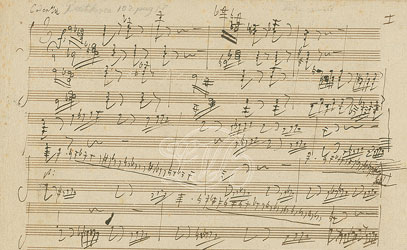
Beethoven's autograph – opening of his piano cadenza |
Even aside from the basic notes, Stowell adds that accents, fingering, bowing, dynamics and other essential expressive components of a performance were largely absent and left to later editions, which invariably would come to reflect the styles of the editors’ respective eras, while the chaotic state of the autograph challenges modern scholars with erratic clues from which to infer Beethoven’s original intentions.
Clement was also a showman – the poster for the premiere announced that he would play a sonata on one string – with the violin held upside down! The new concerto was to be presented in halves, separated by other works, although historians seem unsure as to whether Clement displayed his acrobatic turn within the concerto or at the end of the concert. While all of this seems appalling nowadays, apparently it was consistent with the custom of the time. If nothing else, it calls into question the rigid solemnity of modern concert decorum.
Although the audience reportedly was pleased, critics were hostile. While Clement’s role was lavishly praised, the Weiner Theaterzeitung reported the next day: “As for Beethoven’s concerto, the judgment of the connoisseurs is unanimous; they allow that it has certain passages of beauty, but find that its construction is disjointed and that the endless repetition of certain commonplaces might easily become wearisome.” Another reviewer urged Beethoven to make better use of his talents and continue to produce works in the conservative style of his “charming” and “witty” earlier compositions. During the rest of Beethoven’s life his Violin Concerto was never heard again in Vienna and was given elsewhere only rarely and without success.
For all intents and purposes, the real premiere occurred in London on May 27, 1844 when Joseph Joachim, a 12-year old prodigy, played it in a Philharmonic Society concert led by Felix Mendelssohn.
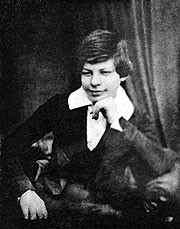
Joseph Joachim (Daguerrotype) |
Ten years earlier, when the work had been introduced to London, the Harmonium sniffed: “Beethoven has put forth no strength in his violin concerto. … It might have been written by a third or fourth rate composer.” But now the musical world took notice. Mendelssohn recalled that Joachim “played so masterfully, so surely and from memory” that the audience constantly interrupted the performance with applause (a further indication of accepted audience deportment of the time). The Morning Post reported: “His execution of this concerto is beyond all praise and defies all description.” Yet, the review observed: “The Concerto … has been generally regarded by violin-players as not a proper and effective development of the powers of their instrument.” Clearly the focus was on the impossibly young and gifted soloist. Thus the Musical World enthused, albeit rather acidly: “So well did he play that we forgot how entirely unadapted for display was the violin part,” as did the Illustrated London News: “In the cadences [i.e., cadenzas], composed by the youth himself, there was as much genius as in the subject which gave birth to them.”
The Concerto then began the long climb to acceptance, although slowly – by 1860 Anton Schindler reported that “only recently” had it come into its own, as violinists had rejected the work as unrewarding and complained that it was unplayable. Tovey attributes their resistance to mistaking its spaciousness for undue length and its quiet mysteries for insignificance. Robert Simpson agrees, calling its mastery unassertive and its sublimity so effortless that criticism confuses cause and effect. Pincherle adds that its semblance to a symphony with a principal violin part had little appeal to soloists' egos. Only more recently has its full stature been appreciated. In his 1969 biography, George Marek reflects the current consensus, calling it “the Mt. Everest of concertos, … the wonder of the form, the challenge to every soloist.”
 Beethoven must have valued his violin concerto far more than his contemporaries, as the very next year he produced a piano version as part of a British publishing package that included his fourth symphony, fourth piano concerto, the three “Razumovsky” Quartets – and the Violin Concerto. Beethoven must have valued his violin concerto far more than his contemporaries, as the very next year he produced a piano version as part of a British publishing package that included his fourth symphony, fourth piano concerto, the three “Razumovsky” Quartets – and the Violin Concerto.
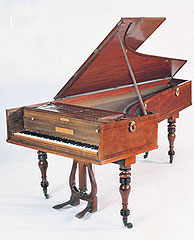
Beethoven's Broadwood fortepiano |
Cooper believes that Beethoven used the opportunity of preparing a piano adaptation to revise the violin version into its final published form. (Although Beethoven had inscribed the autograph with the pun “Concerto per Clemenza pour Clement” (by the grace of and [written] for Clement), he dedicated the published violin version to his violinist friend Stephan von Breuning and the piano version to von Breuning’s new wife Julie, who was the daughter of Beethoven’s former doctor and who would die the next year at age 19.)
Although Beethoven presumably hoped that the piano adaptation would prove more popular than the original, most analysts find it disappointing and even incompetent. Donal Handman regrets that Beethoven hardly ever exploits the possibilities of the piano, of which he was an undisputed master. As Michael Thomas Roeder notes, the violin demands far different treatment than a keyboard when used in a concerto, whose essence consists of contrast between solo instrument and orchestra. Thus, to provide the needed contrast in texture to the string-dominated orchestra, the violin tends to play in its high register while the piano is able to rely on its percussive sound. (The importance of the violin’s timbre and range as essential components is driven home by an arrangement for clarinet and orchestra by Mikhail Pletnev on a DG CD, in which the lower-voiced, mellower soloist tends to blend into the ensemble rather than stand out – indeed, only in the cadenzas does the clarinet’s unique sonority emerge.) Moreover, the violin requires persistent yet lighter accompaniment as it lacks the piano’s power and ability to accompany itself.
The general assessment is that Beethoven largely squandered the need to recast his work into the different idiom that the piano requires. Stowell considers the right-hand part little more than a literal copy of the violin line in a lower register and the new left-hand part banal, consisting mostly of accompanying chords and doubling of the right hand. Indeed, the piano part sounds mostly naked and graceless, especially in contrast to Beethoven's own five genuine piano concerti. Yet much of the problem stems from the inherent differences between the two instruments, which even a genius like Beethoven could not alter or overcome. Thus, the piano cannot effectively convey the smooth sustained notes at which the violin excels, nor can the ease of pressing distant keys approach the thrill and human struggle of a violin straining to reach widely separated notes. The violin, on the other hand, cannot replicate the piano’s ability to sound chords or separate simultaneous musical lines, and consequently the texture of piano transcriptions of violin solos invariably sounds unduly thin. If nothing else, the piano version serves to affirm that Beethoven conceived the concerto idiomatically in terms of the violin. In one respect, though, the piano version is widely hailed – for its cadenza.
 According to C. Hubert H. Parry, cadenzas originated in vocal music so singers could “show off the flexibility, compass and expressive powers of their voices to the highest advantage; so that the piece coming to an end immediately afterwards, the audience might have the impression of an astonishment fresh in their minds to urge them to applause.” The notion then spread to instrumental performance, where cadenzas were launched by a pause on a 6-4 dominant chord and ended on a dominant trill to cue the return of the orchestra. According to C. Hubert H. Parry, cadenzas originated in vocal music so singers could “show off the flexibility, compass and expressive powers of their voices to the highest advantage; so that the piece coming to an end immediately afterwards, the audience might have the impression of an astonishment fresh in their minds to urge them to applause.” The notion then spread to instrumental performance, where cadenzas were launched by a pause on a 6-4 dominant chord and ended on a dominant trill to cue the return of the orchestra.
Joachim's cadenzas for the first movement:


Joachim's Cadenza for the Rondo:

|
Observers close to Beethoven’s time depicted the role of the cadenza in rather modest terms. Thus in his 1753-62 treatise on The True Art of Playing Keyboard Instruments the highly respected Emanuel Bach cautioned that it “should not stray too far into remote keys. Strange chords would be out of place. … [It] should not astonish or shock us.” In his 1789 Klavierschule, David Gottlieb Türk felt compelled “to speak out against the great misuse of decorated cadenzas. For it not seldom seems that a concerto is played mainly for the sake of the cadenzas. In them the performer goes astray not merely in the length that is fitting but also introduces all kinds of passagework, etc., which have not the slightest connection with the work that has preceded, so that the impression made upon the hearer is to a great extent effaced. Monstrously long cadenzas lasting several minutes are on no account to be excused.” In 1840 Carl Czerny, a pupil and close associate of Beethoven, viewed the cadenza as an occasion to display an artist’s refinement: “It must not stop the flow of the piece and it must be in the character of the work.” But the era of the great Romantic virtuosos changed that, seizing upon the cadenza to temporarily shift the spotlight from composer to executant. Thus Parry, writing in 1904, felt that cadenzas should be improvised to display the soloist’s special capacities and “should be either brilliant or very ingenious, containing variety of modulation, … and the more they have the character of abandonment or impulse the better they are.”
Hopkins finds it unlikely that cadenzas were truly spontaneous, as any sensible performer would prepare one in the process of learning a work, although the stimulus of an audience could prompt flights of fancy. While cadenzas were an accepted part of any concerto, Beethoven took the rather radical step in 1809 of specifying that none was to be inserted in his final piano concerto (the “Emperor”) – toward the end of the first movement, after a brief pause the score provides a single solo scalar run that seemingly begs any self-respecting soloist for elaboration, but then states: “Non si fa una cadenza, ma s’attacka subito il seguente” (“Do not make a cadenza, but go immediately to the following”). 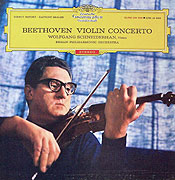 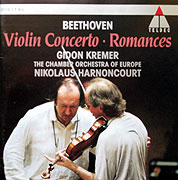 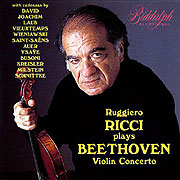 That same year, perhaps to rein in would-be show-offs, he wrote out cadenzas for his four prior piano concertos – three for the first – as well as two for Mozart’s C-minor concerto – but none for the Violin Concerto. That same year, perhaps to rein in would-be show-offs, he wrote out cadenzas for his four prior piano concertos – three for the first – as well as two for Mozart’s C-minor concerto – but none for the Violin Concerto.
Other composers and performers have more than compensated – Martin Wulfhorst catalogs 54 published so far. In a historical survey, Milan Berginc traces their evolution from those in a brief classical style (Spohr, Dont) through lengthy displays of virtuosity (Auer, David, Laub, Vieuxtemps, Wieniawski, Ysaye) full of the language of romanticism – broken triads, arpeggios, octave passages, multiple trills, double-stops. The most prevalent of all are two sets fashioned by Joachim while still in his teens. Donald Francis Tovey recalled hearing Joachim perform them, but in abbreviated form compared to the published versions. Berginc characterizes them as a symphonic treatment of the thematic material insofar as frequent passages played simultaneously on several strings (double-stopping) emulate orchestral texture. Perhaps invoking the showy style of Clement and giving the soloist ample opportunity to display technique, both of Joachim's cadenzas to the first movement begin with Beethoven's introductory timpani figure, but while the first plays with it rather gruffly for a while, the second immediately melds it with one of the sweet violin themes, played in rolled chords to evoke the full instrumentation. Both Joachim's cadenzas for the rondo begin by plunging into a round built on the principal theme of the movement. Also popular is the set written by Fritz Kreisler, that is far more lyric, in keeping with the gentle nature of the work (and his own temperament). A 1994 Ruggiero Ricci CD (on Biddulph) provides an intriguing opportunity to insert any of 14 separately-tracked cadenzas into the first movement. Several of these plus five more obscure ones are available on Ed Chang’s LVB and More website. Many are quite fascinating and inspire a wish that they be heard more often, especially since the familiarity of the Joachim and Kreisler sets tends to seem an integral part of the concerto rather than a soloist's inventive personal departure that adds an intended element of novelty and surprise.
First movement cadenza by Hellmesberger:

First movement cadenza by Busoni:

The marcia section of Beethoven's cadenza:

|
Those of Ferdinand David and Camille Saint-Saëns are among the more modest. At the other extreme, Ferdinand Laub’s has dizzy harmonic modulation and Joseph Hellmesberger begins with defiant runs as if to shake off precedent. In lieu of the pastiche approach, Ferrucio Busoni stakes his independence by creating his own opening figure and adding a part for orchestral basses, and Alfred Schnittke’s grows organically in five minutes from contemplation to a novel fantasy (including the injection of imposing timpani and allusions to other composers).
Thankfully, Beethoven wrote out special cadenzas for the piano version, which help to put the others into a fascinating perspective. Perhaps out of deference to the composer, most cadenzas derive nearly all their material from the themes of the preceding movement and embellish them to varying degrees, but Beethoven himself takes a far different course. After briefly quoting a bold subsidiary theme that immediately precedes the cadenza (the first of the “other” themes depicted above), he takes off on a sequence of chromatic runs in quick modulation, then out of nowhere, with timpani tapping the rhythm, he introduces a quick march comprised of two completely new melodies, hurls us into a seemingly free fantasia fully exploiting both hands, mixes these elements together, and then, after a trill that should but doesn’t cue the return of the orchestra, finally launches into a brief further fantasy on the violin’s lyrical theme. As if to affirm his own independent thought (and perhaps to trigger similar bold digressions in others) Beethoven’s own cadenza for the larghetto is also surprisingly robust and interrupts the steady gentle flow before subsiding into contemplative fragments that lead into the rondo. His cadenzas for the rondo itself (in each of two spots) clear the air with vast torrents of sound that sweep up and down the keyboard. While it’s far from clear whether these should be taken as Beethoven’s own thoughts as to how the cadenzas of the violin version ought to be crafted, they are inventive (and certainly are immune from criticism as inauthentic) and surely exonerate those who follow a personal and iconoclastic muse in advancing their own vision. In 1962 Wolfgang Schneiderhan adapted Beethoven’s piano cadenzas for his violin recording with Eugen Jochum and the Berlin Philharmonic (DG) but made a few cuts and had to slow a few tempos and simplify the density of the piano writing to fit his fiddle. In order to retain all of Beethoven’s notes, in his 1993 recording with the Chamber Orchestra of Europe led by Nikolaus Harnoncourt (Teldec CD) Gideon Kremer arranged the cadenza for violin and piano (and timpani), so that each soloist could play the lines most suitable to its proclivity.
 Mark Katz analyzed dozens of recordings from eight decades and his incisive observations provide a helpful overall guide. Beyond the often-observed slowing of basic tempos as the 20th century progressed, he notes a dwindling within musical phrases of elasticity and temporary fluctuations that had been used in the past to delineate structures and mark transitions. Among other expressive devices, vibrato increased from an occasional embellishment to near omnipresence, portamento (sliding between notes) became far lighter and less frequent (if heard at all) and had a milder impact on rhythm (which in the more heavily-bowed earlier practice functioned as a brief ritenuto [slowing down]), the palette of bowings and timbres (including harmonics) became narrower and more consistent, and coordination between solo and orchestra was tightened. Overall, he concludes that the passionate, emotive, mercurial readings of early recordings became more contemplative, stately and serene. He offers two underlying reasons for this: first, the evolving role of the performer away from interpretation toward objectivity and, second, the impact of technology to replace the need for a strong first impression with the creation of a document that holds up with repeated exposure. Of course, none of these trends is rigidly constant over time nor developed with mathematical precision. Rather, they provide a useful paradigm to evaluate a recording within its era as well as a basis from which to cherish the exceptional examples that transcend the norms of their period. Mark Katz analyzed dozens of recordings from eight decades and his incisive observations provide a helpful overall guide. Beyond the often-observed slowing of basic tempos as the 20th century progressed, he notes a dwindling within musical phrases of elasticity and temporary fluctuations that had been used in the past to delineate structures and mark transitions. Among other expressive devices, vibrato increased from an occasional embellishment to near omnipresence, portamento (sliding between notes) became far lighter and less frequent (if heard at all) and had a milder impact on rhythm (which in the more heavily-bowed earlier practice functioned as a brief ritenuto [slowing down]), the palette of bowings and timbres (including harmonics) became narrower and more consistent, and coordination between solo and orchestra was tightened. Overall, he concludes that the passionate, emotive, mercurial readings of early recordings became more contemplative, stately and serene. He offers two underlying reasons for this: first, the evolving role of the performer away from interpretation toward objectivity and, second, the impact of technology to replace the need for a strong first impression with the creation of a document that holds up with repeated exposure. Of course, none of these trends is rigidly constant over time nor developed with mathematical precision. Rather, they provide a useful paradigm to evaluate a recording within its era as well as a basis from which to cherish the exceptional examples that transcend the norms of their period.
On a parallel social level Potter raises an important distinction between the international superstars with vast repertoire and generic styles to which we have become accustomed and soloists raised in 19th century traditions, who were partly self-taught, were imbued with the concentrated style of a national/regional “school,” had a narrow repertoire of relatively few major works, produced their own distinctive arrangements of shorter pieces to please less sophisticated audiences, and travelled with accompanists who were more personal butlers than comparably skilled artists. Above all else, they were expected to project great individuality and often combined the now-specialized talents of composer and performer.
It’s wise to keep these factors in mind when listening to pioneering recordings.
 The first three recordings of the Violin Concerto were made in the acoustical process, in which the artists crowded into a small room in order to project their sound into a horn that was coupled directly to a stylus that cut the groove into a wax master. Fidelity, dynamics and atmosphere were heavily compromised. The following headnotes list the soloist, orchestra and conductor, the timings of each movement (although the first depends more upon the length of the cadenza than its tempo), the year and original and reissue media. The first three recordings of the Violin Concerto were made in the acoustical process, in which the artists crowded into a small room in order to project their sound into a horn that was coupled directly to a stylus that cut the groove into a wax master. Fidelity, dynamics and atmosphere were heavily compromised. The following headnotes list the soloist, orchestra and conductor, the timings of each movement (although the first depends more upon the length of the cadenza than its tempo), the year and original and reissue media.
- Juan Manen, Orquesta Sinfonica de Barcelona, Concordio Gelabert (1916)
This first recording of the Beethoven Violin Concerto would deserve to be treasured if only for historical reasons,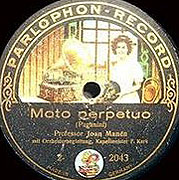 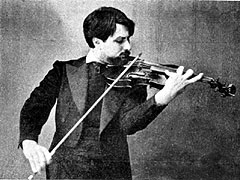 but in fact it turns out to be supremely valuable for esthetic purposes. Routinely overlooked nowadays, Manen was greatly admired and made major acoustical recordings of not only the Beethoven but the Bruch and Mendelssohn concertos (the last twice!). Although he continued to perform through the 1950s, apparently he made no electrical recordings. His style is hard to pinpoint from his extant records – a Paganini “Moto Perpetuo” is rigid and bland (although just hitting all the thousands of rapid-fire notes on target in the days before editing was an achievement in itself), a Sarasate “Jota Aragonesa” (which he recorded at least three times in 1916, 1918 and 1921) is heady and stylish, and a Wieniawski “Legende” is impassioned and highly dramatic. Perhaps most revealing is the finale to the Mendelssohn concerto, taken at breakneck pace but with ample expression, abetted by judicious slides and accents, and relieved by frequent slowing of the tempo to emphasize the faster sections. Yet a New York Times review of a 1920 Carnegie Hall recital dubbed him “an artist of fine attainments and individuality” with a refined and musical style who played with dignity and poise, disposed toward sentiment and delicacy rather than breadth and ruggedness, who made Bach “sound like music and not technical exercises” and who invested a Mozart concerto with “charm, vivacity and finish.” but in fact it turns out to be supremely valuable for esthetic purposes. Routinely overlooked nowadays, Manen was greatly admired and made major acoustical recordings of not only the Beethoven but the Bruch and Mendelssohn concertos (the last twice!). Although he continued to perform through the 1950s, apparently he made no electrical recordings. His style is hard to pinpoint from his extant records – a Paganini “Moto Perpetuo” is rigid and bland (although just hitting all the thousands of rapid-fire notes on target in the days before editing was an achievement in itself), a Sarasate “Jota Aragonesa” (which he recorded at least three times in 1916, 1918 and 1921) is heady and stylish, and a Wieniawski “Legende” is impassioned and highly dramatic. Perhaps most revealing is the finale to the Mendelssohn concerto, taken at breakneck pace but with ample expression, abetted by judicious slides and accents, and relieved by frequent slowing of the tempo to emphasize the faster sections. Yet a New York Times review of a 1920 Carnegie Hall recital dubbed him “an artist of fine attainments and individuality” with a refined and musical style who played with dignity and poise, disposed toward sentiment and delicacy rather than breadth and ruggedness, who made Bach “sound like music and not technical exercises” and who invested a Mozart concerto with “charm, vivacity and finish.”
While this pioneering set appears to have eluded transfer to LP or CD, a generous collector shared audio files of the first and third movements. The first, in particular, is a prime example of Katz’s observation of the era’s intentionally loose coordination between orchestra, which here proceeds at a mostly uniform pace, and soloist, who is far freer, thus subtly enhancing the contrast between the two forces whose juxtaposition lies at the very core of the concerto concept, and far removed from the modern approach of closely integrating them. Indeed, Manen constantly varies the rhythm within individual phrases for a personalized image that is soulful yet fundamentally sweet. To fit the first movement onto four sides it is heavily cut, bypassing the entire orchestral introduction so as to begin with the bare solo entrance, wrapping up each side with a full cadence, and skipping ahead several pages to begin the next one. As most of the omissions are orchestral interludes, the soloist is in nearly constant action, thus leaving no doubt as to the focus. While a bit disconcerting to hear excerpts rather than a truly complete performance, it serves as a valuable reminder that 78 rpm recordings were never meant to be heard continuously as we now do by joining the sides together, but rather in relative isolation with allowances for ample breaks while records were manually (and carefully) changed. (Indeed, in that light it’s rather amazing that the vast majority of multiple disc sets do fit so smoothly.) Most of the fourth side comprises a three-minute cadenza, presumably Manen’s own – fine, inventive and with hints of his Spanish heritage. The rondo, too, is cut by excising orchestral repetitions of the recurring “A” refrain, although this time Manen’s cadenza is barely evident – five seconds long, a mere handful of notes. In 1922 he remade the larghetto (included in Pearl’s The Recorded Violin CD anthology). Although the larghetto is the most refined of the three movements, he exhibits the same highly flexible and expressive phrasing, smooth sliding between notes and warm and tender tone with added embellishments and acciaccaturas (grace notes before a sustained note) that create gentle syncopations. He further applies a barely perceptible but constant deceleration to less than half the initial tempo to subtly shift the mood. Manen’s discs surmount their inherent challenges to preserve a fascinating display of a bold, individual style that is unique among the Concerto’s recordings.
- Isolde Menges, Royal Albert Hall Orchestra, London Ronald (21:50 + 8:30 + 8:25) (1922 – HMV 78s; Pearl LP)
The soloist for this first complete recording was known not only for her passionate commitment to music education 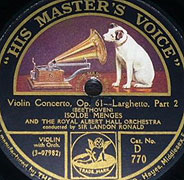 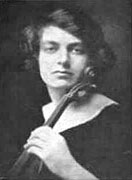 – she gave hundreds of free concerts for schoolchildren – but for her taste, technical finish and tonal beauty, and thus seems an ideal vehicle for the Beethoven concerto. She was also a gender pioneer, forming a famous quartet in a realm and era of male domination. She must have had a vast expressive range – two London Times reviews of 1913 concerts cited her “impulsiveness that borders on recklessness” in the Tchaikovsky concerto and “exceedingly careful control of detail and very great beauty” in the Brahms. She combines both interpretive poles in the Beethoven with deeply empathetic playing without ever wallowing in excess, clean trills and ornaments, fine intonation, light vibrato and a fluid breathing of the musical lines, soaring at the end of phrases and conveying the cadenzas with great freedom (but excising a dozen measures from Joachim I). (Curiously, a Gramophone review carped that “somehow one would ask for a more masculine performance of Beethoven,” a patently ridiculous classification of the guy who wrote the “Moonlight” Sonata and “Für Elise” during the same period – and a sadly narrow view of a composition rich in interpretive possibilities.) Her conductor, too, exhibited a flexible approach to style – among Ronald's many acoustical symphonic recordings of similar vintage are a suitably volatile Tchaikovsky Sixth, a pliant Brahms Second, an ardent Dvorak Ninth and a bracing Beethoven Fifth – and thus was a suitable accompanist who could mold his approach to the personality of the soloist. (Our Gramophone reviewer found his contribution here “respectable but not great” – barely pertinent criticism for a concerto partner.) At least judging from Pearl’s LP transfer, the recording is rather thin, even for its time, although the tympani are bracingly prominent. Ironically, though, the generally high tessitura of the solo stands out especially well against the mid-range resonance of the orchestral texture that the acoustical apparatus tended to blur, although some of the soft stratospheric violin notes apparently exceeded the upper range of the mechanism and barely register. – she gave hundreds of free concerts for schoolchildren – but for her taste, technical finish and tonal beauty, and thus seems an ideal vehicle for the Beethoven concerto. She was also a gender pioneer, forming a famous quartet in a realm and era of male domination. She must have had a vast expressive range – two London Times reviews of 1913 concerts cited her “impulsiveness that borders on recklessness” in the Tchaikovsky concerto and “exceedingly careful control of detail and very great beauty” in the Brahms. She combines both interpretive poles in the Beethoven with deeply empathetic playing without ever wallowing in excess, clean trills and ornaments, fine intonation, light vibrato and a fluid breathing of the musical lines, soaring at the end of phrases and conveying the cadenzas with great freedom (but excising a dozen measures from Joachim I). (Curiously, a Gramophone review carped that “somehow one would ask for a more masculine performance of Beethoven,” a patently ridiculous classification of the guy who wrote the “Moonlight” Sonata and “Für Elise” during the same period – and a sadly narrow view of a composition rich in interpretive possibilities.) Her conductor, too, exhibited a flexible approach to style – among Ronald's many acoustical symphonic recordings of similar vintage are a suitably volatile Tchaikovsky Sixth, a pliant Brahms Second, an ardent Dvorak Ninth and a bracing Beethoven Fifth – and thus was a suitable accompanist who could mold his approach to the personality of the soloist. (Our Gramophone reviewer found his contribution here “respectable but not great” – barely pertinent criticism for a concerto partner.) At least judging from Pearl’s LP transfer, the recording is rather thin, even for its time, although the tympani are bracingly prominent. Ironically, though, the generally high tessitura of the solo stands out especially well against the mid-range resonance of the orchestral texture that the acoustical apparatus tended to blur, although some of the soft stratospheric violin notes apparently exceeded the upper range of the mechanism and barely register.
- Josef Wolfsthal, Berlin State Opera Orchestra, Hans Thierfelder (22:50 + 9:15 + 10:10) (1925, Polydor 78s, Biddulph CD)
- Josef Wolfsthal, Berlin Philharmonic, Manfred Gurlitt (21:20 + 8:50 + 9:05) (1929, Grammophon 78s; Pearl CD)
Born in 1899, Wolfsthal was hailed by Carl Flesch, one of the foremost violinists and pedagogues of his time,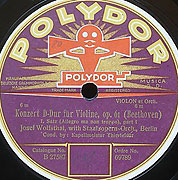 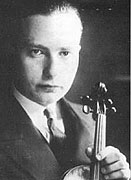 as the best violinist of the next generation and indeed he became concertmaster of the Berlin State Opera at the unheard-of age of 22, which helps to explain why he was chosen for this recording. (Many experts authoritatively state that it was heavily cut, but in fact it is absolutely whole, leading one to wonder if they bothered to hear it.) The timing was unfortunate, as it came at the very end of the acoustical era and thus quickly became obsolete, yet it is far from clear why Wolfsthal was afforded a chance to re-record it so soon in lieu of so many established virtuosos and other rising stars whose interpretations had not been inscribed at all. Alas, in a sense the remake was prescient, as Wolfsthal died of flu the next year at age 31, leaving only these sets, Mozart and Mendelssohn concerti (the latter with piano accompaniment) and a few short pieces to testify to his formidable talent. Potter cites his reputation as volatile and spontaneous (he reportedly ruined a chance to partner with Horowitz in America by fooling around during the audition), but here Wolfsthal only cuts loose in the cadenzas and otherwise applies merely modest inflection to stay well within the bounds of the written score, characterizing the larghetto with considerable empathy and warmth and the rondo with grace and nobility. In the remake the solo sections are mostly comparable, although tonally sweeter, softer and with fewer slides. The accompaniment, though, is overtly more energetic (albeit slower) in the acoustic version, perhaps as compensation for the monotony of the recorded texture. Of the conductors, Thierfelder is forgotten nowadays and Gurlitt nearly so – his primary claim to fame is as the composer of a Wozzeck opera contemporaneous with, but eclipsed by, the version by Berg, although he is better remembered in Japan, to which he emigrated when thrown out of the Nazi party upon suspicion of having Jewish roots. Both versions display a fine feeling for the idiom and are “modern” in the sense of minimizing interpretation out of respect for conveying the essence of the composer and in that sense look forward beyond the bold soloist personalities of their time toward modern sensitivities. as the best violinist of the next generation and indeed he became concertmaster of the Berlin State Opera at the unheard-of age of 22, which helps to explain why he was chosen for this recording. (Many experts authoritatively state that it was heavily cut, but in fact it is absolutely whole, leading one to wonder if they bothered to hear it.) The timing was unfortunate, as it came at the very end of the acoustical era and thus quickly became obsolete, yet it is far from clear why Wolfsthal was afforded a chance to re-record it so soon in lieu of so many established virtuosos and other rising stars whose interpretations had not been inscribed at all. Alas, in a sense the remake was prescient, as Wolfsthal died of flu the next year at age 31, leaving only these sets, Mozart and Mendelssohn concerti (the latter with piano accompaniment) and a few short pieces to testify to his formidable talent. Potter cites his reputation as volatile and spontaneous (he reportedly ruined a chance to partner with Horowitz in America by fooling around during the audition), but here Wolfsthal only cuts loose in the cadenzas and otherwise applies merely modest inflection to stay well within the bounds of the written score, characterizing the larghetto with considerable empathy and warmth and the rondo with grace and nobility. In the remake the solo sections are mostly comparable, although tonally sweeter, softer and with fewer slides. The accompaniment, though, is overtly more energetic (albeit slower) in the acoustic version, perhaps as compensation for the monotony of the recorded texture. Of the conductors, Thierfelder is forgotten nowadays and Gurlitt nearly so – his primary claim to fame is as the composer of a Wozzeck opera contemporaneous with, but eclipsed by, the version by Berg, although he is better remembered in Japan, to which he emigrated when thrown out of the Nazi party upon suspicion of having Jewish roots. Both versions display a fine feeling for the idiom and are “modern” in the sense of minimizing interpretation out of respect for conveying the essence of the composer and in that sense look forward beyond the bold soloist personalities of their time toward modern sensitivities.
 1925 saw the emergence of electrical recording with microphones and amplifiers that quickly relegated the prior acoustical method to the historical dustbin. Unfortunately, many music fans tend to disregard the prior efforts due to their comparatively primitive sound, even though their artistic value remains undiminished. 1925 saw the emergence of electrical recording with microphones and amplifiers that quickly relegated the prior acoustical method to the historical dustbin. Unfortunately, many music fans tend to disregard the prior efforts due to their comparatively primitive sound, even though their artistic value remains undiminished.
- Fritz Kreisler, Berlin State Opera Orchestra, Leo Blech (23:45 + 10:25 + 10:10) (1926, HMV 78s; Naxos Historical CD)
- Fritz Kreisler, London Philharmonic, John Barbirolli (22:30 + 10:25 + 9:55) (1936 – Victor 78s; Naxos Historical CD)
Michael Scott aptly calls Kreisler “the Caruso of fiddlers” 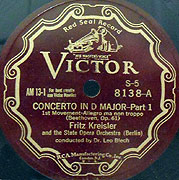 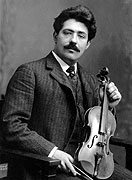 – universally loved, he brought great music to a wider audience beyond those who frequented concert halls (and the then-daring filler to this set was an unaccompanied Bach Adagio). Scott attributes Kreisler's popular appeal to his total expressiveness akin to the eloquence of a great singer; indeed Scott notes that Nellie Melba, arguably the most famous soprano of the time, used Kreisler as a model for her vocal students. Beyond a singing tone, Tully Potter cites his warm, sensuous vibrato applied to every phrase, the extraction of different colors with unusual left-hand positions and sweet tone from light and subtle bow pressure. All this is amply evident in this first electrical recording of the Beethoven Violin Concerto, which is infused with a wealth of sheer wholehearted feeling. Perhaps a remnant of the reduced forces needed for the era of acoustic recording that had just ended, the orchestra sounds like a chamber ensemble and Leo Blech, best known as an opera conductor and thus accustomed to accommodating singers’ quirks, fashions a pliant accompaniment that complements Kreisler’s overflowing warmth – he even rolls the orchestral chords to match those of the soloist. Indeed, the entire approach sounds intimate and conversational. Of course, Kreisler plays his own magnificent cadenzas to all three movements. Although he wrote them when only 19, remarkably he eschews the temptation for blinding youthful virtuostic display or attention-getting shifts in tone and instead seamlessly reflects Beethoven’s artistic context – indeed, the transition that concludes the larghetto luminously melds its dreamy repose with hints of the rollicking rondo to come. All three are played with such natural expression as to sound improvised. Nearly a century later the sheer earnest beauty and conceptual integration of this recording remain awesome – not only historical and historic but immeasurably gratifying and affecting. And if it gives fits to those demanding a more “masculine” Beethoven, so be it. The same forces’ Mendelssohn Violin Concerto, recorded the prior week (and on the same Naxos CD), is equally inviting. Kreisler recut the Beethoven in 1936 with Barbirolli and the London Philharmonic, but while the solo segments survive largely intact (and he plays an interesting variant of the published version of his own second-movement cadenza) the accompaniment seems more conventional and even a bit crude in comparison – the sharper fidelity and dynamics even seem to abrade the geniality of Kreisler’s style nestled within the mellow atmospheric blanket of a decade earlier – although it may appeal to those who view Beethoven in terms of inherent tension and conflict. – universally loved, he brought great music to a wider audience beyond those who frequented concert halls (and the then-daring filler to this set was an unaccompanied Bach Adagio). Scott attributes Kreisler's popular appeal to his total expressiveness akin to the eloquence of a great singer; indeed Scott notes that Nellie Melba, arguably the most famous soprano of the time, used Kreisler as a model for her vocal students. Beyond a singing tone, Tully Potter cites his warm, sensuous vibrato applied to every phrase, the extraction of different colors with unusual left-hand positions and sweet tone from light and subtle bow pressure. All this is amply evident in this first electrical recording of the Beethoven Violin Concerto, which is infused with a wealth of sheer wholehearted feeling. Perhaps a remnant of the reduced forces needed for the era of acoustic recording that had just ended, the orchestra sounds like a chamber ensemble and Leo Blech, best known as an opera conductor and thus accustomed to accommodating singers’ quirks, fashions a pliant accompaniment that complements Kreisler’s overflowing warmth – he even rolls the orchestral chords to match those of the soloist. Indeed, the entire approach sounds intimate and conversational. Of course, Kreisler plays his own magnificent cadenzas to all three movements. Although he wrote them when only 19, remarkably he eschews the temptation for blinding youthful virtuostic display or attention-getting shifts in tone and instead seamlessly reflects Beethoven’s artistic context – indeed, the transition that concludes the larghetto luminously melds its dreamy repose with hints of the rollicking rondo to come. All three are played with such natural expression as to sound improvised. Nearly a century later the sheer earnest beauty and conceptual integration of this recording remain awesome – not only historical and historic but immeasurably gratifying and affecting. And if it gives fits to those demanding a more “masculine” Beethoven, so be it. The same forces’ Mendelssohn Violin Concerto, recorded the prior week (and on the same Naxos CD), is equally inviting. Kreisler recut the Beethoven in 1936 with Barbirolli and the London Philharmonic, but while the solo segments survive largely intact (and he plays an interesting variant of the published version of his own second-movement cadenza) the accompaniment seems more conventional and even a bit crude in comparison – the sharper fidelity and dynamics even seem to abrade the geniality of Kreisler’s style nestled within the mellow atmospheric blanket of a decade earlier – although it may appeal to those who view Beethoven in terms of inherent tension and conflict.
- Joseph Szigeti, British Symphony Orchestra, Bruno Walter (22:25 + 9:50 + 9:32) (1932, Columbia 78s, Pearl CD)
Deeply admired, especially among fellow musicians, 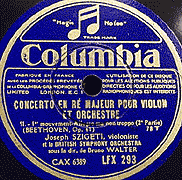 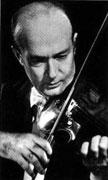 Szigeti was hailed for his eloquence, integrity and deep musicality. He reveled in modern music and could hurl himself into it with total abandon – a 1940 Library of Congress recital with his compatriot Bela Bartok is staggering in its spiky intensity. Yet he acclimated himself to the nature of each piece – a 1939 Bloch concerto, of which he is the dedicatee, is acutely heartfelt while his 1934-5 Mozart and Mendelssohn concerti with Beecham are paradigms of elegant restraint. Here, he is sensitive but not sentimental, sincere but never bland, presenting the musical line with logic and moderating his expression out of presumed deference to the composer, even going so far as to cut eight measures from Joachim’s cadenza in which dramatic descending octave 16th-note scales threaten to disrupt the prevailing tone of temperance. Curiously, though, he shatters the lovely mood of the larghetto with Joachim’s rarely-played alternate cadenza that sounds disjointed and overly aggressive. Looking ahead to the pervasive warmth of his late stereo recordings, Walter provides a far more tempered accompaniment than was his wont at this phase of his career. A 1947 remake with the New York Philharmonic (Lys CD) is essentially similar, with better fidelity and balance but with Szigeti not quite as fresh. Szigeti was hailed for his eloquence, integrity and deep musicality. He reveled in modern music and could hurl himself into it with total abandon – a 1940 Library of Congress recital with his compatriot Bela Bartok is staggering in its spiky intensity. Yet he acclimated himself to the nature of each piece – a 1939 Bloch concerto, of which he is the dedicatee, is acutely heartfelt while his 1934-5 Mozart and Mendelssohn concerti with Beecham are paradigms of elegant restraint. Here, he is sensitive but not sentimental, sincere but never bland, presenting the musical line with logic and moderating his expression out of presumed deference to the composer, even going so far as to cut eight measures from Joachim’s cadenza in which dramatic descending octave 16th-note scales threaten to disrupt the prevailing tone of temperance. Curiously, though, he shatters the lovely mood of the larghetto with Joachim’s rarely-played alternate cadenza that sounds disjointed and overly aggressive. Looking ahead to the pervasive warmth of his late stereo recordings, Walter provides a far more tempered accompaniment than was his wont at this phase of his career. A 1947 remake with the New York Philharmonic (Lys CD) is essentially similar, with better fidelity and balance but with Szigeti not quite as fresh.
- Bronislaw Huberman, Vienna Philharmonic, George Szell (21:05 + 9:10 + 8:30) (1934; Columbia 78s, Naxos Historical CD)
If you wonder why Beethoven, known for his volatile temperament,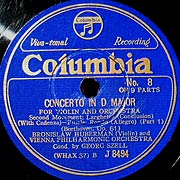 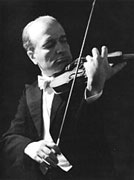 produced such a serene concerto, Huberman provides a partial answer. Known for his free spirit and creativity (Carl Flesch called him “unbridled,” and that wasn’t a compliment), Huberman began studies with Joachim at age 10 but had the gall to reject the famed teacher’s pedantry and left after nine months (although he does play Joachim’s cadenzas here). Outspoken and politically active throughout his life, he promoted the Pan-European movement as a means to world peace and reacted to Nazism by founding the Palestine Symphony Orchestra (now the Israel Philharmonic) with refugees and enlisting Toscanini to nurture its first season. His musicianship was iconoclastic as well, and was already evident in hugely outsized portamento in sides he cut as a teenager in 1899. Here, standing out against Szell’s classical reticence, all the solo sections, and not just the cadenzas, seem improvised and soulful, within the bounds of the score while inferring vast passion beneath the placid surface. A key, in addition to rubato, is his potent bowing that constantly alters the mood, ranging from digging in with gruff force to suspensions of exquisite grace, even within a single phrase or note. Perhaps most remarkable is the rondo, which can seem a bit tedious and repetitive, but here each episode and iteration takes on a fascinating life of its own with compelling and unaccustomed personal touches – even coy whimsy when his final solo run is barely audible. Even more elemental is a 1944 New York concert version with the National Orchestral Association under Leon Barzin (Arbiter CD). Yet, Huberman never disrupts the pastoral essence of the concerto with the flagrant drama he injected into his 1930 recording of the ”Kreutzer” Sonata with fellow Pole Ignaz Friedman and a blistering 1929 Tchaikovsky Violin Concerto with Steinberg in which his spectacular spiccato (bouncing) bowing is on full display. produced such a serene concerto, Huberman provides a partial answer. Known for his free spirit and creativity (Carl Flesch called him “unbridled,” and that wasn’t a compliment), Huberman began studies with Joachim at age 10 but had the gall to reject the famed teacher’s pedantry and left after nine months (although he does play Joachim’s cadenzas here). Outspoken and politically active throughout his life, he promoted the Pan-European movement as a means to world peace and reacted to Nazism by founding the Palestine Symphony Orchestra (now the Israel Philharmonic) with refugees and enlisting Toscanini to nurture its first season. His musicianship was iconoclastic as well, and was already evident in hugely outsized portamento in sides he cut as a teenager in 1899. Here, standing out against Szell’s classical reticence, all the solo sections, and not just the cadenzas, seem improvised and soulful, within the bounds of the score while inferring vast passion beneath the placid surface. A key, in addition to rubato, is his potent bowing that constantly alters the mood, ranging from digging in with gruff force to suspensions of exquisite grace, even within a single phrase or note. Perhaps most remarkable is the rondo, which can seem a bit tedious and repetitive, but here each episode and iteration takes on a fascinating life of its own with compelling and unaccustomed personal touches – even coy whimsy when his final solo run is barely audible. Even more elemental is a 1944 New York concert version with the National Orchestral Association under Leon Barzin (Arbiter CD). Yet, Huberman never disrupts the pastoral essence of the concerto with the flagrant drama he injected into his 1930 recording of the ”Kreutzer” Sonata with fellow Pole Ignaz Friedman and a blistering 1929 Tchaikovsky Violin Concerto with Steinberg in which his spectacular spiccato (bouncing) bowing is on full display.
- Georg Kulenkampff, Berlin Philharmonic, Hans Schmidt-Isserstedt (23:55 + 10:30 + 10:10) (1938, Telefunken 78s, Teldec CD)
Kulenkampff emerged by default as Germany’s top wartime violinist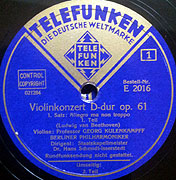 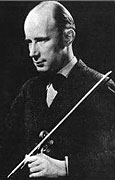 after so many others either were thrown out or fled and is nearly forgotten nowadays, recalled largely for the number of recordings he made. Potter characterizes him as warm and sympathetic but at times incurably bland. Kulenkampff was capable of mustering tangible enthusiasm on records, as in his 1937 Schumann Violin Concerto (the composer’s last work, suppressed by Joachim, its dedicatee, and trotted out by the Nazis as propaganda), considerable personal inflection in a 1939 Tchaikovsky Concerto with Arthur Rother, and even seething depth, as in an altogether startling 1943 Sibelius Concerto with Furtwängler that turns its virtuostic display into a thing of mystery and menace (although the atmosphere admittedly was crafted largely by the conductor). Here, though, partnered by a rather non-descript conductor known more for respect than interpretive insight, all hints of drama are muted, as the emotional peaks are soothed, transitions are exceptionally fluid and all is suffused in a sweet aura that aptly dwells on the lyrical sections. Even so, the acoustic is reverberant and the fidelity uncommonly detailed for its time, affording an opportunity rare for such vintage to focus on the instrumental balances. after so many others either were thrown out or fled and is nearly forgotten nowadays, recalled largely for the number of recordings he made. Potter characterizes him as warm and sympathetic but at times incurably bland. Kulenkampff was capable of mustering tangible enthusiasm on records, as in his 1937 Schumann Violin Concerto (the composer’s last work, suppressed by Joachim, its dedicatee, and trotted out by the Nazis as propaganda), considerable personal inflection in a 1939 Tchaikovsky Concerto with Arthur Rother, and even seething depth, as in an altogether startling 1943 Sibelius Concerto with Furtwängler that turns its virtuostic display into a thing of mystery and menace (although the atmosphere admittedly was crafted largely by the conductor). Here, though, partnered by a rather non-descript conductor known more for respect than interpretive insight, all hints of drama are muted, as the emotional peaks are soothed, transitions are exceptionally fluid and all is suffused in a sweet aura that aptly dwells on the lyrical sections. Even so, the acoustic is reverberant and the fidelity uncommonly detailed for its time, affording an opportunity rare for such vintage to focus on the instrumental balances.
- Karl Freund, Berlin Philharmonic, Walther Davisson (23:10 + 11:15 + 8:45) (1938, Polydor 78s)
- Max Strub, Saxon Staatskapelle, Karl Bohm (21:55 + 10:55 + 9:45) (1939, Electrola 78s)
And speaking of non-descript, the largely characterless and unremarkable Polydor set was cut by two unknowns. 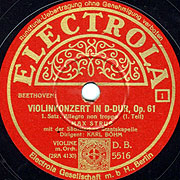 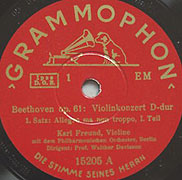 It has been suggested that the main motivation was financial, as the parent Grammophon company was in need of a modern recording to compete with its primary rival and had few accomplished artists meeting governmental (that is, racial) approval among whom to choose. Freund had cut a Schubert Sonatina in 1937 and Davisson, director of the Leipzig Conservatory, later made some concerto recordings for Vox in the mid-50s (the Brahms Double and Second Piano Concertos and the Beethoven Triple). About all that can be said for this venture, apparently their only collaboration, is that the notes are played accurately – until we get to the cadenzas. Remarkably, in lieu of the standard choices Freund plays magnificent versions by the Belgian violinist and composer Hubert Léonard (1819 – 1890) – fine 19th century examples of this form, full of gentle figurations, in which Léonard distills several themes, techniques and emotional overtones while proceeding with logic and demanding ample technique without breaching a consistently temperate flavor. At the same time, Léonard manages to preserve a deep respect for the composer by hesitating to inject too much of himself or his own ideas that might otherwise overwhelm the dimension of the work or breach Beethoven’s style. Léonard’s cadenzas are a magnificent breath of fresh air in contrast to the cluttered and often egotistical displays of Joachim, et. al., and should be far better known and chosen more often. Perhaps to proselytize for their excellence, Freund plays them with a degree of finesse lacking in the rest of his routine. If for no other reason (and I really can’t think of any), this set is worth hearing for its splendid and hugely tasteful and fluent cadenzas. Rounding out a triad of pre-War German recordings, chamber musician and concertmaster Strub also departs from the standard canon of first-movement cadenzas to meander among scraps of others, even including a brief snippet of Beethoven’s march with timpani from his piano adaptation. To counter his approximate intonation and harsh tone in rapid passages, Strub tends to shine in the lyrical sections and the entire Larghetto, although Bohm’s rather gray accompaniment never soars and the finale is drained of spirit. Even so, the recording is impressive for its unusually wide dynamic range, documenting German technological prowess even as its prime artists fled. It has been suggested that the main motivation was financial, as the parent Grammophon company was in need of a modern recording to compete with its primary rival and had few accomplished artists meeting governmental (that is, racial) approval among whom to choose. Freund had cut a Schubert Sonatina in 1937 and Davisson, director of the Leipzig Conservatory, later made some concerto recordings for Vox in the mid-50s (the Brahms Double and Second Piano Concertos and the Beethoven Triple). About all that can be said for this venture, apparently their only collaboration, is that the notes are played accurately – until we get to the cadenzas. Remarkably, in lieu of the standard choices Freund plays magnificent versions by the Belgian violinist and composer Hubert Léonard (1819 – 1890) – fine 19th century examples of this form, full of gentle figurations, in which Léonard distills several themes, techniques and emotional overtones while proceeding with logic and demanding ample technique without breaching a consistently temperate flavor. At the same time, Léonard manages to preserve a deep respect for the composer by hesitating to inject too much of himself or his own ideas that might otherwise overwhelm the dimension of the work or breach Beethoven’s style. Léonard’s cadenzas are a magnificent breath of fresh air in contrast to the cluttered and often egotistical displays of Joachim, et. al., and should be far better known and chosen more often. Perhaps to proselytize for their excellence, Freund plays them with a degree of finesse lacking in the rest of his routine. If for no other reason (and I really can’t think of any), this set is worth hearing for its splendid and hugely tasteful and fluent cadenzas. Rounding out a triad of pre-War German recordings, chamber musician and concertmaster Strub also departs from the standard canon of first-movement cadenzas to meander among scraps of others, even including a brief snippet of Beethoven’s march with timpani from his piano adaptation. To counter his approximate intonation and harsh tone in rapid passages, Strub tends to shine in the lyrical sections and the entire Larghetto, although Bohm’s rather gray accompaniment never soars and the finale is drained of spirit. Even so, the recording is impressive for its unusually wide dynamic range, documenting German technological prowess even as its prime artists fled.
- Jascha Heifetz, NBC Symphony Orchestra, Arturo Toscanini (21:15 + 8:45 + 8:30) (1940, Victor 78s, Naxos Historical CD)
Unlike Grammophon, RCA's roster burst with an abundance of talent. Indeed, Potter suggests that this recording may have arisen so RCA could “play their two aces”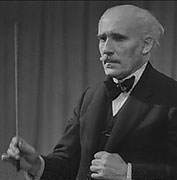 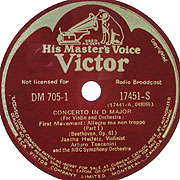 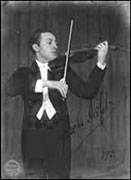 – their most famous instrumentalist and their most famous conductor. Yet marketing considerations turned out to be trumped by esthetics. Heifetz’s sensational technique, pure tone and athletic confidence gleam within Toscanini’s frank, focused classicism and the studio’s dry acoustic. The clipped momentum of the accompaniment enables the solos to emerge as sweet and patient by comparison, and thereby exemplifies the ability of a sophisticated concerto to serve as a study in subtle contrast. Even so, Heifetz adds ample inflection and Toscanini is far from rigid – as the first movement progresses there’s a tangible mellowing as if the violin is sensing expressive opportunities to tame the orchestra, which indeed sounds downright chastened after the brilliant precision of the cadenza (written by Leopold Auer, Heifetz’s mentor). The larghetto is sheer magic as Heifetz keeps his vast reserves of strength under full control – subtle sensitivity without disturbing the formal design, to largely infer the emotions Beethoven embedded – an epitome of how a musical whisper can prove far more potent than overt histrionics. The essence of the genre – contrast – returns to be exemplified in the rondo, which alternates between vigor and affection. Some may consider the result cold and mechanical compared to others, but perhaps Beethoven speaks as effectively through direct, unembellished presentation than more heavily inflected and personalized approaches. (Even so, despite Heifetz's reputation for streamlining, we should note that Katz’s analysis found that he used more portamento than any other soloist, although they tend to be lithe and barely evident.) For all Toscanini’s reputed fanatic insistence on his interpretive ideals, the conception here would seem to have been decreed by Heifetz, as it emerges barely altered in a 1945 New York Philharmonic concert under Rodzinski (on a Music and Arts CD) and yet again in his 1955 stereo remake with the Boston Symphony under Munch. Although both offer improved sonics and Heifetz’s perpetually youthful artistry remains undiminished, they lack the emphatic edge and elemental tension mustered by Toscanini. – their most famous instrumentalist and their most famous conductor. Yet marketing considerations turned out to be trumped by esthetics. Heifetz’s sensational technique, pure tone and athletic confidence gleam within Toscanini’s frank, focused classicism and the studio’s dry acoustic. The clipped momentum of the accompaniment enables the solos to emerge as sweet and patient by comparison, and thereby exemplifies the ability of a sophisticated concerto to serve as a study in subtle contrast. Even so, Heifetz adds ample inflection and Toscanini is far from rigid – as the first movement progresses there’s a tangible mellowing as if the violin is sensing expressive opportunities to tame the orchestra, which indeed sounds downright chastened after the brilliant precision of the cadenza (written by Leopold Auer, Heifetz’s mentor). The larghetto is sheer magic as Heifetz keeps his vast reserves of strength under full control – subtle sensitivity without disturbing the formal design, to largely infer the emotions Beethoven embedded – an epitome of how a musical whisper can prove far more potent than overt histrionics. The essence of the genre – contrast – returns to be exemplified in the rondo, which alternates between vigor and affection. Some may consider the result cold and mechanical compared to others, but perhaps Beethoven speaks as effectively through direct, unembellished presentation than more heavily inflected and personalized approaches. (Even so, despite Heifetz's reputation for streamlining, we should note that Katz’s analysis found that he used more portamento than any other soloist, although they tend to be lithe and barely evident.) For all Toscanini’s reputed fanatic insistence on his interpretive ideals, the conception here would seem to have been decreed by Heifetz, as it emerges barely altered in a 1945 New York Philharmonic concert under Rodzinski (on a Music and Arts CD) and yet again in his 1955 stereo remake with the Boston Symphony under Munch. Although both offer improved sonics and Heifetz’s perpetually youthful artistry remains undiminished, they lack the emphatic edge and elemental tension mustered by Toscanini.
- Louis Zimmermann, Concertgebouw Orchestra, Willem Mengelberg (21:15 + 9:10 + 9:15) (1940, Tahra CD)
This performance functions mostly as a “teaching moment.” 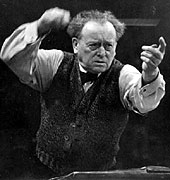 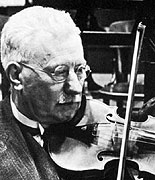 Great violinists use nuance and expressive techniques tastefully and logically to project a coherent vision that enhances the bare notation and humanizes what otherwise is an abstract pattern of sound. To have served as the long-time concertmaster of the famed Concertgebouw Orchestra – 41 years with a five-year break! – Zimmermann clearly must have been more than merely competent and was well attuned to its esteemed conductor’s deeply personal style. I try to be positive, so let me take the coward’s way out and quote Jed Distler in his classicstoday.com review, in which he slams Zimmermann’s “god-awful solo work. [His] simpering tone, gypsy-like phrasing, cloying portamento and sketchy technique give new meaning to the words vulgar and provincial.” Maybe Zimmermann was having an off-night, or perhaps he was crushed by emotion in the face of his imminent retirement (which would explain the prolonged applause following the first movement, far more deserved for sentimentality than for the actual performance), but his intonation is painfully awry and his expression is not only grotesquely exaggerated but seems random and meaningless. The saving grace is the extremely inventive cadenzas, presumably Zimmermann’s own – relatively brief, stylistically appropriate, quite colorful and, in contrast to the rest, rather well executed. Overall, Mengelberg’s setting seems brusque and (for him) rather straightforward, as if he was eager to get it over quickly. (A 1926 Zimmermann studio recording issued only in Holland, formerly assumed to be with Mengelberg and the Concertgebouw, now is attributed to an unidentified orchestra led by Charles Woodhouse and reportedly had far better musicianship.) A more representative model of Mengelberg’s famed shaping of orchestral color and pacing is found in his 1943 Concertgebouw concert with Guila Bustabo (Tahra CD), whose solos mesh sweetness, brilliance and precision (and sustain the larghetto for nearly 12 minutes). Alas, her career reversed the usual route of her era – born in America, she emigrated to Germany, where she remained throughout the Nazi era and largely was shunned after that. Great violinists use nuance and expressive techniques tastefully and logically to project a coherent vision that enhances the bare notation and humanizes what otherwise is an abstract pattern of sound. To have served as the long-time concertmaster of the famed Concertgebouw Orchestra – 41 years with a five-year break! – Zimmermann clearly must have been more than merely competent and was well attuned to its esteemed conductor’s deeply personal style. I try to be positive, so let me take the coward’s way out and quote Jed Distler in his classicstoday.com review, in which he slams Zimmermann’s “god-awful solo work. [His] simpering tone, gypsy-like phrasing, cloying portamento and sketchy technique give new meaning to the words vulgar and provincial.” Maybe Zimmermann was having an off-night, or perhaps he was crushed by emotion in the face of his imminent retirement (which would explain the prolonged applause following the first movement, far more deserved for sentimentality than for the actual performance), but his intonation is painfully awry and his expression is not only grotesquely exaggerated but seems random and meaningless. The saving grace is the extremely inventive cadenzas, presumably Zimmermann’s own – relatively brief, stylistically appropriate, quite colorful and, in contrast to the rest, rather well executed. Overall, Mengelberg’s setting seems brusque and (for him) rather straightforward, as if he was eager to get it over quickly. (A 1926 Zimmermann studio recording issued only in Holland, formerly assumed to be with Mengelberg and the Concertgebouw, now is attributed to an unidentified orchestra led by Charles Woodhouse and reportedly had far better musicianship.) A more representative model of Mengelberg’s famed shaping of orchestral color and pacing is found in his 1943 Concertgebouw concert with Guila Bustabo (Tahra CD), whose solos mesh sweetness, brilliance and precision (and sustain the larghetto for nearly 12 minutes). Alas, her career reversed the usual route of her era – born in America, she emigrated to Germany, where she remained throughout the Nazi era and largely was shunned after that.
- Erich Röhn, Berlin Philharmonic, Wilhelm Furtwängler (23:50 + 10:45 + 8:46) (1944, DG CD)
- Yehudi Menuhin, Berlin Philharmonic, Wilhelm Furtwängler (23:50 + 10:25 + 9:45) (1947, Music and Arts CD)
- Yehudi Menuhin, Philharmonic, Wilhelm Furtwängler (23:50 + 9:35 + 10:15) (1953, EMI CD)
Nearly all concerto performances focus upon, and are driven by, the soloist. These three guide us on a conductor’s spiritual journey. It’s hard to avoid reading a political context into Furtwängler’s wartime concerts, which constantly expose a tormented soul struggling with conflict and doubt. 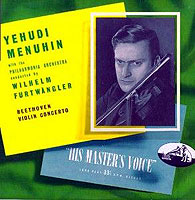 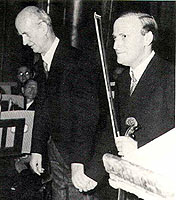 Here a pervasive sadness infects the entire 1944 reading – the sonority is dark and brooding, the tympani defiant, the orchestra, hollow and cautious, swamping the soloist (the Berlin Philharmonic’s concertmaster) whose attempts to freshen and charm emerge as cloying and futile. The larghetto is all whispers, a forlorn oasis of calm shattered by the final orchestral chords. The finale, thrown off balance by rushing the final two notes of each phrase of the bounding theme, fitfully staggers among moods, the refrain sounding joyless and overwhelming the episodes as if there were to be no escape from oppression. Here a pervasive sadness infects the entire 1944 reading – the sonority is dark and brooding, the tympani defiant, the orchestra, hollow and cautious, swamping the soloist (the Berlin Philharmonic’s concertmaster) whose attempts to freshen and charm emerge as cloying and futile. The larghetto is all whispers, a forlorn oasis of calm shattered by the final orchestral chords. The finale, thrown off balance by rushing the final two notes of each phrase of the bounding theme, fitfully staggers among moods, the refrain sounding joyless and overwhelming the episodes as if there were to be no escape from oppression.
After the War many musicians spurned Furtwängler, who had remained in Germany even after an Allied tribunal fully exonerated him. Playing for displaced persons in 1946, Menuhin heard first-hand accounts of Furtwängler’s valor and became his advocate. Although his support fell largely on deaf ears, Menuhin, an American Jew who believed in music as a force of healing and peace, transmuted his gesture of conscience into action and effected an artistic reconciliation of which their 1947 Berlin concert is a precious souvenir. In the allegro the storm clouds are all dispersed and tension dissipated as soloist and orchestra meld into a united vision of empathy and human warmth, furthered by the sweet Kreisler cadenza in lieu of the more austere Joachim one used by Röhn. The larghetto is suffused with genuine affection and the rondo is patient and patrician without becoming bland. Admittedly a rather one-dimensional view of a work into which Beethoven poured a complexity of feeling, it provides a striking departure from the depressing wartime posture. While lacking the historical import of the Berlin concert, the 1953 studio recording with an English orchestra is comparable in style and architecture, if even more smooth and polished, but conveys much of the soulfulness and vision that were the artists’ respective hallmarks. In a related vein is a 1952 concert with David Oistrakh and the Berlin Radio Symphony Orchestra led by Hermann Abendroth, who crafts an especially dark setting in which the timpani remain assertive throughout, but unfortunately the impact is compromised by loud and persistent coughing (Tahra CD).
- Ginette Neveu, Southwest German Radio Orchestra, Hans Rosbaud (23:55 + 9:50 + 10:25) (1949; Music and Arts CD)
In many ways air travel transformed our cultural world,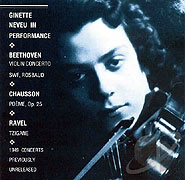 quickly transporting top artists to distant lands where audiences could thrill to their talent and vastly expand the ranks of their ardent fans, but it also cruelly deprived us of three artists who arguably would have become the top musicians of their generation – conductor Guido Cantelli, pianist William Kapell and violinist Ginette Neveu, all killed in air crashes while on concert tours. Potter undoubtedly meant it as a compliment when he wrote that Neveu played the Beethoven Concerto “with the strength and dash of a man.” Indeed, she made no pretense of being “feminine” or playing in the stereotyped tender manner expected of her gender. Rather, the overriding quality of her few recordings is their sincerity and focus, although her exquisite vibrato, subtle gradations of tone and carefully-sculpted dynamics do tend to emerge most compellingly in quiet, lyrical sections (I’ve never been a huge fan of her acclaimed 1946 Sibelius Violin Concerto led by Walter Susskind), all of which is to say that she was an ideal interpreter of the Beethoven concerto, which she never lived to record. Captured in concert one month before she died en route to America, this performance boasts an especially moving larghetto in which each note receives its due, with Rosbaud and his orchestra in full sync. Neveu was already a formidable, mature artist, and was taken from us far too soon. We can only mourn for the many decades of her career that remained unfulfilled and celebrate opportunities such as this to revel in the shards of her art that survive. quickly transporting top artists to distant lands where audiences could thrill to their talent and vastly expand the ranks of their ardent fans, but it also cruelly deprived us of three artists who arguably would have become the top musicians of their generation – conductor Guido Cantelli, pianist William Kapell and violinist Ginette Neveu, all killed in air crashes while on concert tours. Potter undoubtedly meant it as a compliment when he wrote that Neveu played the Beethoven Concerto “with the strength and dash of a man.” Indeed, she made no pretense of being “feminine” or playing in the stereotyped tender manner expected of her gender. Rather, the overriding quality of her few recordings is their sincerity and focus, although her exquisite vibrato, subtle gradations of tone and carefully-sculpted dynamics do tend to emerge most compellingly in quiet, lyrical sections (I’ve never been a huge fan of her acclaimed 1946 Sibelius Violin Concerto led by Walter Susskind), all of which is to say that she was an ideal interpreter of the Beethoven concerto, which she never lived to record. Captured in concert one month before she died en route to America, this performance boasts an especially moving larghetto in which each note receives its due, with Rosbaud and his orchestra in full sync. Neveu was already a formidable, mature artist, and was taken from us far too soon. We can only mourn for the many decades of her career that remained unfulfilled and celebrate opportunities such as this to revel in the shards of her art that survive.
- Mischa Elman, London Symphony Orchestra, Georg Solti (25:45 + 10:15+ 10:45) (1955; Decca/London LP)
At age 64, Elman displays the zenith of the Russian-Jewish school of violinists,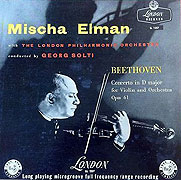 his brilliant technique (already in full evidence on 78s he had cut for Victor in 1910) still fully intact. Deeply personal, infused with unabashed feeling, it constantly calls attention to itself with huge distensions of rhythm and dynamics, broad accents and measured tempos – waves of varying intensity even wash over a single sustained trill – yet without suggesting ego run amok, but rather a direct extension of the artist conveying his heartfelt emotions through his instrument. When soloist and composer fall out of synch, as in Elman’s 1929 Tchaikovsky Concerto with Barbirolli, the result can seem erratic and arbitrary, but here all share the same wavelength. Elman plays his own cadenzas that stray far afield from Beethoven’s materials but are playful, light and fit impeccably into the overall aura of sweet marvel he conveys. (The timing of the first movement partly reflects the length of his cadenza – 4:35 as opposed to about 3 minutes for Joachim’s and Kreisler’s.) By crafting a forthright accompaniment, a young Solti keeps the spotlight focused on Elman. Depending on one’s outlook and expectations, some may find Elman’s approach to be an unseemly intrusion of interpretive personality into the intellectual vigor behind an immutable masterpiece, while others will cherish a profoundly moving conveyance of human emotion that enhances its impact and attempts to ensure that the art of the past will become a living experience for new generations. his brilliant technique (already in full evidence on 78s he had cut for Victor in 1910) still fully intact. Deeply personal, infused with unabashed feeling, it constantly calls attention to itself with huge distensions of rhythm and dynamics, broad accents and measured tempos – waves of varying intensity even wash over a single sustained trill – yet without suggesting ego run amok, but rather a direct extension of the artist conveying his heartfelt emotions through his instrument. When soloist and composer fall out of synch, as in Elman’s 1929 Tchaikovsky Concerto with Barbirolli, the result can seem erratic and arbitrary, but here all share the same wavelength. Elman plays his own cadenzas that stray far afield from Beethoven’s materials but are playful, light and fit impeccably into the overall aura of sweet marvel he conveys. (The timing of the first movement partly reflects the length of his cadenza – 4:35 as opposed to about 3 minutes for Joachim’s and Kreisler’s.) By crafting a forthright accompaniment, a young Solti keeps the spotlight focused on Elman. Depending on one’s outlook and expectations, some may find Elman’s approach to be an unseemly intrusion of interpretive personality into the intellectual vigor behind an immutable masterpiece, while others will cherish a profoundly moving conveyance of human emotion that enhances its impact and attempts to ensure that the art of the past will become a living experience for new generations.
 Here at the brink of the stereo era I’ll stop. But what about all the later recordings? Indeed there are many fine ones, including some personal favorites: the fleet 1955 Milstein/Steinberg (Capitol/EMI, with Milstein’s own fluent cadenzas), the patient yet assertive 1959 Stern/Bernstein (Columbia/Sony), the slender but sweet and warm 1961 Francescatti/Walter (Columbia/Sony), the elegant 1964 Grumiaux/Davis (Philips), the regal 1966 Menuhin/Klemperer (Angel/EMI) and the earnest Perlman with either Giulini (1981, Angel/EMI) or Barenboim (1990, EMI). Here at the brink of the stereo era I’ll stop. But what about all the later recordings? Indeed there are many fine ones, including some personal favorites: the fleet 1955 Milstein/Steinberg (Capitol/EMI, with Milstein’s own fluent cadenzas), the patient yet assertive 1959 Stern/Bernstein (Columbia/Sony), the slender but sweet and warm 1961 Francescatti/Walter (Columbia/Sony), the elegant 1964 Grumiaux/Davis (Philips), the regal 1966 Menuhin/Klemperer (Angel/EMI) and the earnest Perlman with either Giulini (1981, Angel/EMI) or Barenboim (1990, EMI). 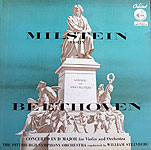 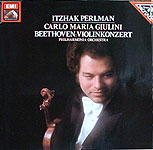 Many listeners will prefer these or others to the ones I’ve listed, but I feel that they largely replicate the styles of the pioneers. And please don’t mistake the scope and purpose of this article – not to assert and advocate the "best" recording but rather to survey interpretive approaches, as well as to salute (and perhaps even to crusade for) older readings of historical importance that, unfortunately, tend to be overlooked nowadays. Many listeners will prefer these or others to the ones I’ve listed, but I feel that they largely replicate the styles of the pioneers. And please don’t mistake the scope and purpose of this article – not to assert and advocate the "best" recording but rather to survey interpretive approaches, as well as to salute (and perhaps even to crusade for) older readings of historical importance that, unfortunately, tend to be overlooked nowadays.
That said, I recognize that music is a reproductive art that requires new perspectives and renditions by each succeeding generation. In that light, it seems appropriate to recognize the major ensuing trend of historically-informed recordings that take a fresh view by emulating the sounds of Beethoven’s era, in terms of both actual instruments and performance practices. 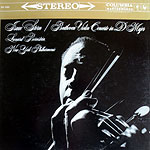 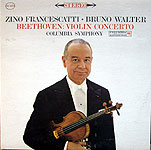 Such efforts transcend mere historical curiosity, as they recall the aural image that Beethoven undoubtedly had in mind while crafting his work, and thus provide fascinating insight into his creative process. The several recordings of the Violin Concerto that strive for authenticity all boast lowered pitch, smaller ensembles, steady tempos, minimal vibrato and balances with a softer solo instrument and more prominent winds and brass than in a modern orchestra. Most also revive the tradition of fresh cadenzas. Stephanie Chase (with Roy Goodman and the Hanover Band; Cala, 1993) presents exceptionally wide dynamics and sweet solos, with her own cadenzas that are soft-spoken (I) and bouncy (III). As with the Kremer/Harnoncourt already noted, Thomas Zehetmair (with Frans Brüggen and the Orchestra of the 18th Century; Philips, 1998) plays an adaptation of Beethoven’s piano cadenzas, but places the violin more prominently against a crisply articulated ensemble. Vera Beths (with Bruno Weil and Tafelmusik; Vivarte 1998) picks up the pace, especially in their seven-minute larghetto that seems a bit perfunctory but adds an unusual sense of earnest forward motion, although the first-movement cadenza by Dutch cellist Anner Byksma, while commendably brief, is rather sour, brusque and only vaguely connected to the major themes. Viktoria Mullova (with John Eliot Gardiner and the Orchestre Révolutionnaire et Romantique (Philips, 2003) opts for cadenzas by Italian Baroque keyboard specialist Ottavio Dantone that probe gently into the thematic material. Harking back to the more personalized renditions of an earlier age, all of these provide a valuable entree into the composer's values as well as a valid basis against which to appraise conventional recordings. Such efforts transcend mere historical curiosity, as they recall the aural image that Beethoven undoubtedly had in mind while crafting his work, and thus provide fascinating insight into his creative process. The several recordings of the Violin Concerto that strive for authenticity all boast lowered pitch, smaller ensembles, steady tempos, minimal vibrato and balances with a softer solo instrument and more prominent winds and brass than in a modern orchestra. Most also revive the tradition of fresh cadenzas. Stephanie Chase (with Roy Goodman and the Hanover Band; Cala, 1993) presents exceptionally wide dynamics and sweet solos, with her own cadenzas that are soft-spoken (I) and bouncy (III). As with the Kremer/Harnoncourt already noted, Thomas Zehetmair (with Frans Brüggen and the Orchestra of the 18th Century; Philips, 1998) plays an adaptation of Beethoven’s piano cadenzas, but places the violin more prominently against a crisply articulated ensemble. Vera Beths (with Bruno Weil and Tafelmusik; Vivarte 1998) picks up the pace, especially in their seven-minute larghetto that seems a bit perfunctory but adds an unusual sense of earnest forward motion, although the first-movement cadenza by Dutch cellist Anner Byksma, while commendably brief, is rather sour, brusque and only vaguely connected to the major themes. Viktoria Mullova (with John Eliot Gardiner and the Orchestre Révolutionnaire et Romantique (Philips, 2003) opts for cadenzas by Italian Baroque keyboard specialist Ottavio Dantone that probe gently into the thematic material. Harking back to the more personalized renditions of an earlier age, all of these provide a valuable entree into the composer's values as well as a valid basis against which to appraise conventional recordings.

As always, I’ll take full credit and blame for my musical opinions and judgments, while acknowledging the following sources for the information (for which I did little independent research), references and quotations in this article, for all of which I am indebted and grateful:
- ON BEETHOVEN
- Cooper, Barry: Beethoven (Oxford, 2000)
- Lockwood, Lewis: Beethoven – the Music and the Life (Norton, 2003)
- Marek, George R.: Beethoven – Biography of a Genius (Funk & Wagnalls, 1969)
- Solomon, Maynard: Beethoven (Schirmer, 1998)
- ON THE CONCERTO
- Stowell, Robin: Beethoven – Violin Concerto (Cambridge University Press, 1998) [a primary resource, hence listed first]
- Brown, Clive: “The Violin Concertos of Franz Clement and Ludwig van Beethoven,” notes to the Pine/Serebrier CD (Cedille CDR-90000, 2006)
- Coldicott, Anne-Louise: “Concertos and Other Orchestral Music” in Cooper, Barry (ed): The Beethoven Compendium (Borders Press, 1991)
- Handman, Donal: [untitled] notes to the Kreisler/Barbirolli reissue LP (Angel COLH-11, 1958)
- Hopkins, Anthony: The Seven Concertos of Beethoven (Ashgate, 1996)
- Johnson, David: [untitled] notes to the Francescatti/Walter LP (Columbia MS 6263, 1961)
- Lang, Paul Henry: Music in Western Civilization (Norton, 1941)
- Picherle, Marc: [untitled] notes to the Kreisler/Barbirolli reissue LP (Angel COLH-11, 1958)
- Roeder, Michael Thomas: A History of the Concerto (Amadeus Press, 1994)
- Scott, Michael: [untitled] notes to Kreisler/Blech LP reissue (HMV Treasury HLM 7062, 1965)
- Simpson, Robert: “Beethoven and the Concerto” in Layton, Robert (ed): A Guide to the Concerto (Oxford, 1988)
- Steinberg, Michael: The Concerto (Oxford, 1998)
- Tovey, Francis Donald: Essays in Musical Analysis – Volume 3 – Concertos (Oxford, 1936)
- ON THE CADENZAS
- Berginc, Milan: “Beethoven’s Violin Concerto and Cadenzas of Beethoven’s Violin Concerto” (Masters Thesis, University of Agder, Kristiansand, Norway. 2010)
- Chang, Ed: “A Cadre of Cadenzas” (http://lvbandmore.blogspot.com/2010/09/91-cadre-of-cadenzas.html)
- Hailparn, Lydia: “Exploring Cadenzas to Beethoven’s Piano Concertos” (College Music Symposium, October 1, 1981)
- Parry, C. Hubert H.: “Cadenza,” article in Groves Dictionary of Music and Musicians (1954 edition)
- Wolfhorst, Martin: “A Comprehensive Catalogue of Cadenzas for Beethoven’s Violin Concerto, Op. 61” (www.martin-wulfhorst.com/beethoven)
- ON VIOLINISTS
- Aldrich, Richard: [untitled] review of Juan Manen 1920 Carnegie Hall recital (New York Times, November 17, 1920)
- Boyden, David D. and Peter Walls: “Violin” – article in The New Groves Dictionary of Music and Musicians (2001 edition, volume 26)
- Campbell, Margaret: The Great Violinists (Grenada, 1980)
- Cowan, Robert [untitled] notes to “Bronislaw Hubermann – The Complete Brunswick Recordings” (Biddulph CD set LAB 077-8, 1993)
- Eshbach, Robert W.: “Joseph Joachim – Biography and Research – London Philharmonic Debut” (http://josephjoachim.com/2013/07/03/philharmonic-debut/)
- Katz, Mark: “Beethoven in the Age of Mechanical Reproduction – the Violin Concerto on Record” (University of Illinois Beethoven Forum 1101 (Spring, 2003)
- Potter, Tully: [untitled] notes to The Recorded Violin – The History of the Violin on Record (Pearl CD sets BVA-1 and BVA-2, 1990)
- Schwartz, Boris: Great Masters of the Violin (Simon & Schuster, 1983)

Copyright 2016 by Peter Gutmann
|
